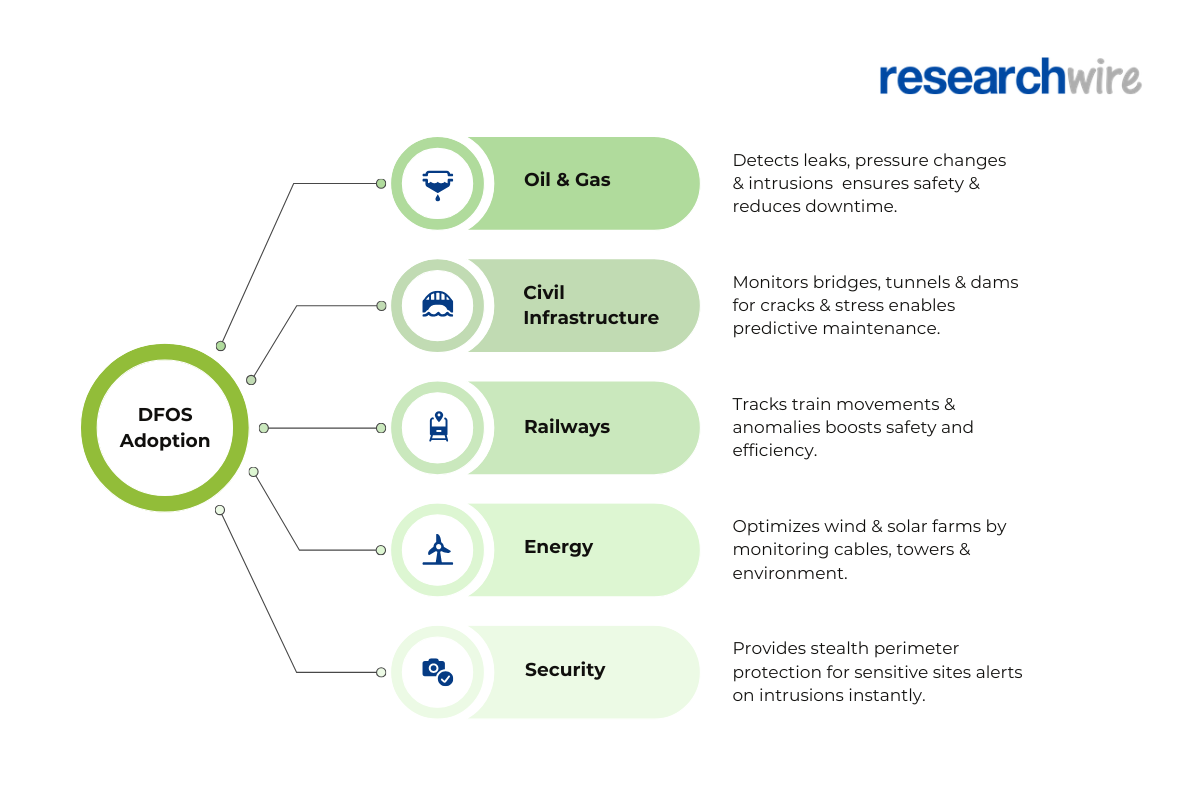In an increasingly connected and data-driven world, infrastructure monitoring is undergoing a significant transformation. One of the most promising technologies at the forefront of this change is Distributed Fiber Optic Sensing (DFOS). Traditionally, monitoring the structural integrity of critical assets like pipelines, bridges, tunnels, and railways has relied on discrete sensors that are often costly, limited in coverage, and prone to failure. DFOS offers a paradigm shift enabling continuous, real-time monitoring over long distances using standard optical fibers. In this blog, we explore how DFOS is revolutionizing infrastructure monitoring, its applications across industries, the evolving intellectual property (IP) landscape surrounding the technology, and how Researchwire supports innovators in protecting and capitalizing on DFOS breakthroughs.
What is Distributed Fiber Optic Sensing?
Distributed Fiber Optic Sensing is a method of converting standard optical fibers into dense sensor arrays that provide temperature, strain, vibration, or acoustic data along their entire length. Unlike conventional sensors that give data from specific points, DFOS enables a single optical fiber to function as thousands of sensors simultaneously, capturing granular data in real time. The core principle involves sending pulses of light through the fiber and analyzing the backscattered signal, which changes in response to environmental factors. Techniques like Optical Time Domain Reflectometry (OTDR) and Optical Frequency Domain Reflectometry (OFDR) are commonly used to interpret these signals.
Real-World Applications of DFOS
DFOS is increasingly being adopted in various sectors, where real-time, reliable, and scalable monitoring is essential:
- Oil & Gas: DFOS is used to monitor pipelines for leaks, pressure changes, and external intrusions. By detecting anomalies early, companies can prevent environmental disasters and reduce downtime.
- Civil Infrastructure: Bridges, tunnels, and dams are equipped with DFOS to detect strain, displacement, and cracking. It ensures safety and extends the lifecycle of infrastructure by enabling predictive maintenance.
- Railways: DFOS detects train movements, track anomalies, and unauthorized access, improving operational efficiency and safety.
- Energy: In wind and solar farms, DFOS helps monitor cables, towers, and environmental conditions to optimize performance.
- Security: Perimeter intrusion detection systems use DFOS for sensitive facilities like airports, data centers, and military bases. It provides early warnings of unauthorized access without relying on visible hardware.
The IP and Patent Landscape of DFOS
As DFOS technology becomes more sophisticated, the intellectual property landscape surrounding it is growing in complexity. Companies are racing to patent innovations in sensing algorithms, deployment methods, signal processing techniques, and fiber designs. Unlike traditional sensor patents, DFOS-related patents often intersect multiple domains optics, data science, civil engineering, and AI.
Patent applicants must address a number of critical questions:
- What aspects of the DFOS system are novel?
- How does the system uniquely interpret backscatter data?
- Is the innovation hardware-based, software-based, or a combination of both?
Moreover, securing patents for data analytics algorithms that process fiber optic data presents its own set of challenges, particularly with global variations in patent laws regarding software and algorithmic inventions. As such, a strategic IP approach is essential for companies developing DFOS technologies.
Data Ownership and Commercialization
A significant component of DFOS innovation lies in the interpretation and analysis of the vast amounts of data it generates. Proprietary analytics platforms can provide a competitive edge, transforming raw fiber data into actionable insights. This raises another layer of IP concerns: who owns the data and the models trained on it? While raw data may not be patentable, the processes and algorithms for interpreting it can be. Firms are increasingly treating their data and analytics tools as valuable trade secrets or filing for method and system patents to secure their technological edge.
Companies Leading in DFOS Development
Several companies are pushing the envelope in DFOS applications:
- Schlumberger
A global technology leader in energy and DFOS solutions, known for its Optiq fiber-optic sensing portfolio covering DAS, DTS, DTGS, and DSTS technologies. Strong focus on digitalization and sustainability.
- Halliburton
Major energy services provider with advanced DFOS products like the Odassea Subsea Fiber Optic Solution for real-time reservoir monitoring and seismic imaging.
- Yokogawa Electric Corporation
Known for sophisticated fiber optic sensing products and systems, with expertise in process automation and industrial monitoring.
- China National Petroleum Corporation
Major state-owned energy company integrating advanced fiber optic sensing technologies for enhanced downhole monitoring and asset integrity.
- Sintela
Specialist in distributed fiber optic sensing technology, partnering with industry leaders to develop advanced sensing solutions across energy and environmental sectors.
- Otsuka Chemical
Chemical company focused on research and development in pharmaceuticals and advanced materials, collaborating on innovative sensing technologies.
The Role of Researchwire in DFOS IP Protection
As a trusted partner in intellectual property management, Researchwire plays a pivotal role in helping DFOS innovators protect and maximize the value of their technologies. Our expertise spans technical documentation, patent strategy, and regulatory compliance across jurisdictions. For developers working at the intersection of optics, data science, and infrastructure, we offer tailored services that include:
- Patent Drafting & Filing: Assisting in crafting strong, defensible patents for DFOS-related innovations, including sensor designs and data processing techniques.
- Freedom to Operate (FTO) Analysis: Helping companies assess whether their technologies infringe on existing patents, minimizing legal risks.
- IP Landscape Mapping: Providing a detailed view of the competitive and technological landscape to guide R&D and investment decisions.
- Trade Secret Advisory: Advising clients on when to patent and when to protect innovations as trade secrets, especially in the context of proprietary algorithms and data models.
The Road Ahead
Distributed Fiber Optic Sensing is no longer just a promising idea it’s a transformative force reshaping how we monitor and manage critical infrastructure. As adoption grows, so too will the need for strategic IP management, data governance, and cross-disciplinary collaboration. Researchwire remains committed to supporting innovators in navigating this dynamic space, ensuring their technologies are not only groundbreaking but also well-protected.
From smarter cities to safer pipelines, DFOS is poised to become the backbone of tomorrow’s infrastructure and those who master its development and protection today will define the future.




